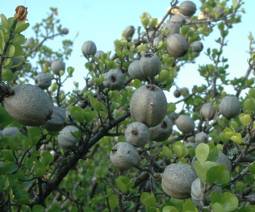Gardenia volkensii
Gardenia volkensii K.Schum.
Family: Rubiaceae
Common names: bushveld gardenia, Transvaal gardenia (Eng.); Transvaalkatjiepiering, bosveldkatjiepiering, kannetjieboom, stompdoring (Afr.); morala (Northern-Sotho, Tswana); ntsalala (Tsonga); umgongwane (Zulu)
SA Tree No: 690.8 and 691
Introduction
The bushveld gardenia is a small, relatively slow-growing tree, ideal as a focus plant in summer rainfall gardens or on patios.

Description
Description
Small, multi-stemmed tree with a dense, rounded crown, 3-8 m high with arching branches, sometimes touching the ground. The bark is pale grey and smooth and the branchlets appear knobbly due to persistent leaf-like appendages at the base of the leaf stalk (stipules). The glossy, green leaves are usually in groups of three and crowded at the end of short branches. The leaves are spoon-shaped with a broadly rounded tip and a tapering base. They have small pockets of hair in some axils of veins (domatia) and a wavy margin. The flowers are solitary, large (up to 100 mm in diameter), and showy with a sweet scent. The trumpet-like flowers are white turning yellow with age, with a long tube that opens up into 6-9 lobes. The flowers open during the night and are probably moth-pollinated.

The flowering season ranges from July to December (winter to summer) and the fruits ripen between December and April (summer to autumn), but may remain on the tree until August. The fruit is almost round, shallowly to strongly ribbed longitudinally, greyish green to white with white, slightly raised dots (lenticels). The fruit contains numerous seeds embedded in pulp.

Two subspecies occur in southern Africa. They are distinguished on fruit characters but this is not always possible, especially in the case of herbarium specimens. Gardenia volkensii subsp. volkensii differs from subsp. spatulifolia by the larger, white fruit with coarser ribs and conspicuous white dots (lenticels). G. volkensii subsp. volkensii var. saundersiae has a calyx with well-developed lobes (15-25 mm long) while G. volkensii subsp. volkensii var. volkensii has calyx lobes up to 10-15 mm long.
Distribution and habitat
Distribution description
Gardenia volkensii prefers open woodland, bushveld and thicket and occurs from tropical Africa through Namibia, Botswana, and the northeastern parts of South Africa into KwaZulu-Natal in the southeast.
Derivation of name and historical aspects
History
The genus Gardenia comprises ± 60 species of which 6 occur in southern Africa.
The name Gardenia commemorates Alexander Garden, a medical doctor from South Carolina; volkensii - was named after the plant collector, G. Volkens, who collected on Mount Kilimanjaro (1892-1894); spathulifolia - leaves shaped like a spatula.
Ecology
Ecology
Fruit are eaten by monkeys, baboons, elephants and large antelope. Leaves are browsed by game, e.g. giraffe, kudu and impala.
Uses
Use
Used medicinally as a cure for intestinal worms. Infusions of the fruit and roots are used to induce vomiting. The ash of burnt roots is rubbed into the chest to treat pneumonia, while headaches are treated by dripping an extract into the eyes or by placing a cold compress on the forehead. For earache an extract is dripped into the ear.
The wood is very hard and suitable for carving ornaments, and plants are also believed to protect against lightning or evil spirits.

Growing Gardenia volkensii
Grow
These plants are easily grown from cuttings or seed.
Sow seed in sand and keep moist. Re-plant seedlings into well-drained soil mixture when they have at least 3 leaves. Water young plants regularly during first season and protect from frost and cold wind.
The plants are relatively slow-growing but make an attractive garden plant in sunny, well-drained spots. They are fairly drought-resistant but not resistant to frost. They have a non-aggressive root system and are therefore suitable for small gardens as well as patios. This Gardenia also makes a beautiful bonsai plant.
Also see G. cornuta and G. thunbergia.
References
- Coates Palgrave, M. 2002. Keith Coates Palgrave Trees of southern Africa, edn 3. Struik, Cape Town.
- Leistner, O.A. (ed.). 2000. Seed plants of southern Africa: families and genera. Strelitzia 10. National Botanical Institute, Pretoria.
- Pooley, E. 2003. The complete field guide to trees of Natal, Zululand & Transkei, edn 4. Natal Flora Trust, Durban.
- SAPPI tree spotting, Lowveld. Jacana, Johannesburg.
- Smith, C.A. 1966. Common names of South African plants. Memoirs of the Botanical Survey of South Africa No. 35.
- Van Wyk, A.E. (Braam) & Van Wyk, P. 1997. Field guide to trees of southern Africa. Struik, Cape Town.
Credits
Hester Steyn
National Herbarium, Pretoria
August 2010
Plant Attributes:
Plant Type: Shrub, Tree
SA Distribution: KwaZulu-Natal, Limpopo, Mpumalanga
Soil type: Sandy, Loam
Flowering season: Spring, Early Summer, Late Summer, Autumn, Sporadic/All year
PH: Neutral
Flower colour: White
Aspect: Full Sun
Gardening skill: Easy
Special Features:
Horticultural zones











Rate this article
Article well written and informative
Rate this plant
Is this an interesting plant?
Login to add your Comment
Back to topNot registered yet? Click here to register.